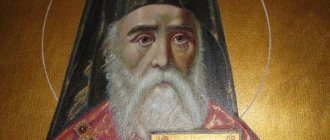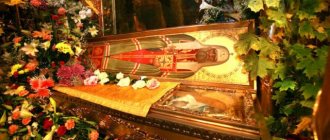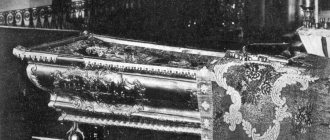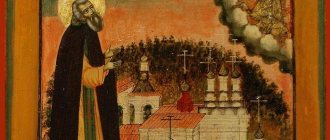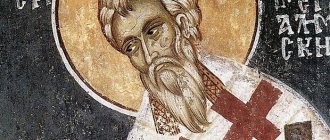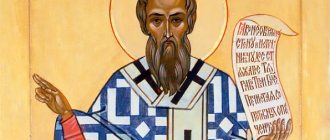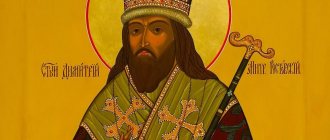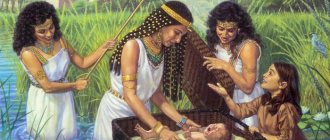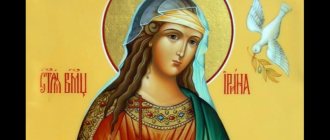Memorial Days: January 18(31), June 9(22)
Cyril of Alexandria was born and raised in Alexandria, being a representative of the famous episcopal dynasty. His uncle was Theophilus of Alexandria, after whom he became primate in 412.
One of the first to expose the heresy of Nestorius, he was the organizer and main protagonist of the Third Ecumenical Council in Ephesus. He owns numerous polemical works refuting the Nestorian teaching about Christ. St. Cyril was the first to formulate the doctrine of the unity of the hypostasis of the Savior, which was interpreted by future Monophysites as an affirmation of the unity of His essence. He also owns interpretations of the Holy Scriptures, explanations of the doctrine of the Trinity, and a number of letters of theological content.
In addition to church activities, he had great influence on the secular government of Alexandria. Therefore, his name is associated with episodes of numerous conflicts between pagans and Christians. He enjoyed unquestioned authority among the urban population and monastics, and after his death he enjoyed good memory.
Saint Cyril ruled the Alexandrian Church for 32 years: by the end of his fruitful activity, the flock was cleansed of heretics.
Saint Cyril died in 444, leaving behind many creations. Particularly noteworthy are the Commentaries on the Gospels of Luke, John, the Epistles of the Apostle Paul to the Corinthians and Hebrews, as well as an apology in defense of Christianity against Emperor Julian the Apostate (361–363). Of great importance are five books against Nestorius, a work on the Most Holy Trinity, called “Treasure,” written against Arius and Eunomius, and two dogmatic works on the Most Holy Trinity, distinguished by the accuracy of their presentation of the Orthodox teaching on the Procession of the Holy Spirit. An essay against anthropomorphism was written by St. Cyril for some Egyptians who, out of ignorance, represented God in human form. Among the works of St. Cyril there are also “Conversations”, among which the “Sermon on the Exodus of the Soul”, placed in the Slavic “Followed Psalter,” is especially touching and edifying.
CREATIONS
Exegetical
Despite the fact that St. Cyril had to write a lot against his enemies; the main part of his legacy is not polemical, but exegetical treatises. St. Cyril was a brilliant commentator on the Bible and in his interpretations followed the allegorical method, which puts him on a par with Origen and other Alexandrians. However, unlike Origen, he did not consider all the details of Old Testament history to have spiritual significance. He paid little attention to the historical and philological analysis of the text, but his interpretations always included polemics with heretics.
17 books On worship and service in Spirit and truth, written in the form of dialogues between St. Cyril and Palladius, represent an allegorical explanation of individual passages of the Pentateuch, chosen not in the order in which they appear in the Bible, but in the order that is most convenient for the author to confirm his main idea. St. Cyril proves that the letter of the law has been abolished, but the spirit has not, and therefore the interpretation of the Old Testament texts should not be literal, but allegorical. In the 1st book of St. Cyril speaks about the deliverance of man from slavery to sin and the devil, in 2nd and 3rd - about justification through Christ, in 4-5 - about human will, in 6-8 - about love for God and neighbor, in 9-13 - about the Church and the priesthood, in 14-16 - about the spiritual worship of Christians, and in the 17th - about Jewish holidays, especially Easter. The treatise was written after the episcopal consecration of St. Cyril, but before the start of the anti-Nestorian polemic (412 - 429).
13 books of Skillful Interpretations (“Glafira”) were written during the same period of the saint’s life and also contain an explanation of selected passages from the Pentateuch, but in the order of their occurrence in the Bible. In the book. 1-7 discusses the book of Genesis, 8-10 - Exodus, 11 - Leviticus, 12 - Numbers, 13 - Deuteronomy.
The interpretation of the prophet Isaiah was written, most likely, after the exegetical works on the Pentateuch, but before 429 and consists of five books. St. Cyril offers the reader a “double” interpretation, including “history,” i.e., the literal meaning of the text, and “theory,” its allegorical explanation.
The Commentary on the Twelve Prophets consists of 12 parts, divided into volumes. After an extensive introduction in which St. Cyril points to previous exegetes, his own interpretation follows, and each book is preceded by its own preface.
In the Catenas, fragments from other interpretations of St. are preserved on the Old Testament. Cyril: on the books of Kings, Psalms and biblical songs, Proverbs, Song of Songs, Jeremiah, Ezekiel and Daniel. Fragments of interpretations of St. Cyril on Ezekiel are preserved in an Armenian manuscript kept at Oxford University (Bodleian Library). About the comments of St. Patriarch Photius mentions Cyril on the psalms (“Library”, no. 229). In the literature there are references to other biblical works of St. Kirill, which have not reached us. From the Commentary on the Gospel of Matthew, written by St. Cyril after 428, only a few fragments have survived. This interpretation was known to Leontius of Byzantium, Ephraim of Antioch and Facundus of Hermian.
The collection of Discourses on Luke the Evangelist was preserved in the Syriac version of the 6th - 7th centuries. , including 156 conversations, while only three conversations and some fragments have survived in Greek. The discourses contain a strong anti-Nestorian polemic, and the reference to the anathematisms shows that these discourses were delivered around 430.
Of the 12 books of Commentaries on John the Evangelist, 10 books (1-6, 9 - 12) have survived in their entirety, and two (7 and - in fragments, the authenticity of which is doubtful. The commentary of St. Cyril is of a dogmatic-polemical nature, which the author points out in introduction. St. Cyril finds in the Gospel of John evidence of the consubstantiality of the Son with the Father, refuting the teachings of the Arians and Eunomians, as well as the Christology of the Antiochian school. The name of Nestorius, as well as the term “Theotokos,” are absent from the interpretation, so it is assumed that it was compiled before 429.
in fragments, the authenticity of which is doubtful. The commentary of St. Cyril is of a dogmatic-polemical nature, which the author points out in introduction. St. Cyril finds in the Gospel of John evidence of the consubstantiality of the Son with the Father, refuting the teachings of the Arians and Eunomians, as well as the Christology of the Antiochian school. The name of Nestorius, as well as the term “Theotokos,” are absent from the interpretation, so it is assumed that it was compiled before 429.
Dogmatic-polemical and apologetic
Early dogmatic-polemical works of St. Cyril directed against the Arians. The treatise Treasure, on the Holy and Consubstantial Trinity, was presumably written at the beginning of the bishopric of St. Cyril, no later than 425. The treatise consists of 35 chapters. In the triadology of St. Cyril follows his predecessor St. Afanasy. Part of the treatise is a reproduction of the 3rd book of St. Afanasy "Against the Arians". As one of the sources of St. Cyril uses the book of Didymus “Against Eunomius”.
The Treatise on the Holy and Life-Giving Trinity was written shortly after “Treasure” and is a revision of the latter. The treatise is dedicated to the “brother” Nemesius and consists of seven dialogues between the author and his friend Hermias: six dialogues talk about the Son, and the seventh talks about the Holy Spirit. The first anti-Nestorian treatise, Five Books against Nestorius, was written around 430. It is a critical analysis of a collection of sermons published by Nestorius in the previous year. Nestorius' name is not mentioned in the text, but quotes from his works are provided. In the first book of St. Cyril examines the passages in which Nestorius speaks out against calling Mary the Mother of God; four other books deal with the two natures of Christ.
The Treatise on the Right Faith, written in 430, consists of three letters sent to St. Cyril to the imperial palace regarding the Nestorian heresy. The first is addressed to Tsar Theodosius, the other two to the queens (without names). According to John of Caesarea (VI century), the second letter is addressed to the emperor’s younger sisters, Arcadia and Marina, and the third, to the elder sister Pulcheria and the emperor’s wife Eudokia.
Twelve anathematisms against Nestorius were written in the same year 430 on behalf of the Council in Alexandria. St. Cyril was forced to defend his anathematisms in three apologies. The first is called the Defense of the Twelve Chapters against the Eastern Bishops and is directed against Andrew of Samosata, who accused St. Cyril in Apollinarianism and Monophysitism. From the accusations of Theodoret of Cyrus to St. Cyril defends himself in a Letter to Euoptius, Bishop of Ptolemais in Libya, from whom he received the text of Theodoret’s work against anathematism. Both treatises were written before the Third Ecumenical Council. The third treatise in defense of anathematisms, entitled Explanation of the Twelve Chapters, was written in the Ephesian prison, where St. Cyril was in August - September 431 after the Third Ecumenical Council.
A defensive word to Tsar Theodosius was written by St. Cyril immediately after his return from Ephesus to Alexandria. In the Word he defends his actions before and during the Council of Ephesus.
The scholia on the Incarnation of the Only Begotten were written after 431: in them St. Cyril gives an explanation of the names Christ, Emmanuel and Jesus, after which he defends the hypostatic unity of natures, refuting opinions about the “mixture” and “connection” between them. Essay against the Apollinarians. The full text survives in Latin, Syriac and Armenian versions; Only a part of the Greek original has survived.
In the dialogue About the fact that Christ is one St. Cyril refutes the teaching that the Word of God did not become flesh, but was united with the man Jesus, so that the honor of the First does not belong to the Second. St. Cyril refers to his early polemic with Nestorius and demonstrates such maturity of thought that the dialogue, highly valued in antiquity, appears to be one of the later works of St. Kirill.
The Small Book against those who do not want to recognize the Holy Virgin as the Mother of God continues the anti-Nestorian polemic. This treatise as a genuine work of St. Cyril was referred to in 542 by Emperor Justinian in his “Tale against the Monophysites.”
In his treatise Against Diodorus and Theodore, St. Cyril refutes the doctrine of Nestorius' teachers - Diodorus of Tarsus and Theodore of Mopsuestia. The treatise consists of three books: the 1st is dedicated to Diodorus, the 2nd and 3rd to Theodore. The treatise was written around 438. Fragments have survived in Greek and Latin versions. Also preserved in fragments is the treatise Against Anthropomorphites.
The treatise Against the Sinusiasts , that is, against the extreme Apollinarians (“Sinusia” - the coexistence of two natures) was written in the late period of the saint’s life and is preserved in fragments in Greek and Syriac.
A monumental apologetic work on the holy Christian religion against the godless Julian was written between 433 and 441, that is, after reconciliation with John of Antioch, but before the death of the latter, since from the 83rd letter of Bl. Theodoret makes it clear that St. Cyril sent this essay to John. It is dedicated to Emperor Theodosius II and contains a refutation of the treatises of Julian the Apostate “Against the Galileans”. Julian published three treatises under this title in 363. Preface by St. Cyril shows that paganism was still strong in his time and Julian’s treatises with accusations against Christians were popular. Only the first ten books of St. Cyril, where he examines the 1st treatise of Julian and talks about the connections between Christianity, Judaism and paganism. Fragments from the 11th and 20th books, which have survived in the Greek and Syriac versions, show that books 11-20 were talking about the second treatise of Julian. J. Newman suggests that in subsequent books of St. Cyril refuted the 3rd treatise of Julian and in total there were about 30 books in his work. However, nothing has survived from the supposed books 21-30: it is possible that St. Cyril did not intend to refute all of Julian’s treatises, but limited himself to only the first two (Quasten J., pp. 129-130).
Easter messages
Like his predecessors - Ev. Athanasius, Peter and Theophilus of Alexandria, St. Cyril annually addressed his flock with a message regarding the date of Easter. Publishers of the works of St. Kirill collected 29 messages under the general title Easter conversations. They were written between 414 and 442. and are devoted primarily to moral and ascetic themes: fasting and abstinence, vigil and prayer, works of charity and mercy. Dogmatic issues are also discussed: in Conversations 5, 8, 17 and 27 St. Cyril defends the doctrine of the Incarnation against the Arians and other heretics who deny the eternity of the Son; Discourse 12 deals with the Holy Trinity. Many conversations contain polemics with Jews and pagans.
Conversations
From the sermons delivered by St. Cyril during his episcopal service in Alexandria, no more than 22 have survived, some of which have survived in fragments. The publishers called them Other Conversations in contrast to Easter Conversations (epistles). The first eight conversations were delivered in Ephesus during the Third Ecumenical Council. Of these, the 1st was pronounced at the beginning of the Council, the 2nd - on the day of memory of the Apostle John the Theologian, the 5th - after the condemnation of Nestorius, the 6th - after the break with John of Antioch, the 7th - before the arrest. The 4th discourse, In praise of the Holy Mary the Mother of God, delivered between June 23 and 27, 431 in the Church of the Blessed Virgin Mary in Ephesus, is the most famous sermon in antiquity dedicated to the Blessed Virgin Mary: St. Cyril calls Her “an unquenchable lamp”, “the crown of virginity”, “the scepter of Orthodoxy”, “the indestructible temple”, “the container of the Inconceivable” - some of these expressions were later included in the Akathist to the Most Holy Theotokos. Conversations 3, 15, 16 and 20 talk about the Incarnation of the Son of God. Discourse 10, On the Last Supper, probably belongs to Theophilus of Alexandria; The 11th is nothing more than the 4th conversation, expanded and supplemented in the 7th -9th centuries. The 13th, On the Week of Vai, goes back to Eulogius of Alexandria. The famous 14th conversation, On the Exodus of the Soul from the Body and on the Second Coming of Christ, which was especially popular in the Middle Ages (it was placed in the Slavic Followed Psalter), is a work of dubious authenticity: in the Apophthegm of the Fathers it is mentioned as the work of Theophilus of Alexandria. Conversations 8, on the Transfiguration of the Lord, and 12, on the Presentation of the Lord, belong to the corpus of Conversations on the Gospel of Luke (see above).
Letters
Collection of letters from St. Cyril, printed in the Patrology of Min, includes 88 letters, of which 17 are letters from others addressed to him, and some are forged. Most of the letters to St. Cyril date back to the time after the Council of Ephesus. For the history of relations between East and West, the correspondence of St. Cyril with Popes Celestine and Sixtus. On letters to St. Cyril was subsequently referred to by the Ecumenical Councils: letter 4, the second to Nestorius, was read out at the III, IV and V Ecumenical Councils. Letter 17, the third to Nestorius, contains a description of the acts of the Council of Alexandria in 430. In letter 39, to John of Antioch, St. Kirill expresses joy at the reconciliation that has taken place: it begins with the words “Let the heavens rejoice.” The three indicated letters (4, 17, 39) due to their dogmatic significance received the name “ecumenical”. Letter 76 contains the refusal of St. Cyril to enter the name of John Chrysostom in the diptychs. Letter 80, from Hypatia to Cyril, is forged, as is letter 86, from Cyril to Pope Leontius.
Liturgy of St. Cyril of Alexandria
In the name of St. Cyril is the name of one of the liturgies used in the Coptic Church. The Greek text of this liturgy is unknown, and since St. Cyril did not write in Coptic; its affiliation with this saint is excluded. The liturgy consists of an anaphora, similar in content to the so-called anaphora of the Apostle Mark. It has been suggested that the Coptic liturgy of St. Cyril is nothing more than a Coptic version of the anaphora of the Apostle Mark. But the question of the origin of the liturgy of St. Cyril of Alexandria has not been fully studied (see: Archimandrite Cyprian Kern. Eucharist. Paris. pp. 99 - 100).
Life of St. Cyril of Alexandria
Kirill is the Archbishop of Alexandria. He earned his memory among Christians by the fact that he defended church interests with confidence and tenacity throughout his life. A fighter for justice, he put the benefit of the clergy above his own benefit.
Origin and early years
Little is known about the origins of the saint. Researchers claim that the year of his birth was 376. He was raised by his mother and uncle, who lived in northeastern Egypt. The boy received a basic Christian education: he studied rhetoric, grammar, theology and theology.
Serving God
There were bishops and archbishops in Cyril's family. He began serving the Lord with his ordination to the primary rank. Gradually, the future saint moved up the career ladder, simultaneously creating numerous works in which he expressed thoughts about the meaning of Christianity.
Death of a Saint
The saint died while serving in his diocese. Until his last days, he successfully led the parishes entrusted to him, wrote notes, and made notes for posterity. He foresaw his death more than once, was prepared for it and prayed daily for the health of his students.
Customs and traditions of June 22 on St. Kirill's Day
It is believed that on June 22 the Sun gives all its power to the earth! People also tried to absorb as much solar energy as possible, so they spent the whole day in nature, going to the river or to the forest.
According to popular beliefs, the sun is especially hot on St. Cyril’s Day; our ancestors were afraid that it would burn the crops. Therefore, early in the morning they turned to the luminary with a request not to be too hot. And we definitely thanked the sun for the warmth and light it gave us.
Today is a favorable day for collecting plants and performing rituals to protect against evil spirits, fulfill desires, and attract wealth and good luck.
Iconography
The archbishop is traditionally depicted in Greek icons wearing a golden vestment. He is depicted in full height as if he is performing one of the divine services. The saint's hands are occupied with scrolls on which parts of texts from the Holy Scriptures are written.
The second type of iconic image involves the appearance of the archbishop from the waist up. This option is more common. The saint appears as an experienced old man, holding the Holy Scriptures in his hands. With one hand he makes a blessing gesture. Most often, Cyril’s icons are painted in the well-known Byzantine style, which includes all works of this type, with thin faces and narrow body parts.
Due to the period of iconoclasm that swept the countries, many ancient paintings were lost. Lists made from ancient images follow the basic line of the originals.
There is a unique painting that depicts Cyril next to his predecessor, a representative of the theological school of Alexandria, Athanasius. Both archbishops stand shoulder to shoulder with scrolls in their hands. They bless the believers with appropriate gestures.
Memorial Day of St. Cyril, Archbishop of Alexandria
Saint Cyril,
Archbishop of Alexandria, an outstanding fighter for Orthodoxy and a great teacher of the Church, came from a noble and pious Christian family. He studied secular sciences, including philosophy, but most of all he sought to acquire knowledge of the Holy Scriptures and the truths of the Christian faith. In his youth, Saint Cyril entered the monastery of Saint Macarius in the Nitrian Mountains, where he stayed for six years. Patriarch Theophilus of Alexandria (385–412) ordained him to the rank of deacon, ranked him among the clergy and, seeing his talent, instructed him to preach sermons.
After the death of Patriarch Theophilus, Saint Cyril was unanimously elected to the Patriarchal throne of the Church of Alexandria and led the fight against the heresy of Novatian, which had spread in Alexandria, who taught that Christians who had fallen away from the Church during persecution could not be accepted again by it.
Saint Cyril, seeing the ineffectiveness of the exhortations of the heretics, achieved their expulsion from Alexandria. More dangerous for the Church were the Jews, who repeatedly caused disturbances, accompanied by the brutal murders of Christians. The saint had to struggle with this for a long time. To put an end to the remnants of paganism, the saint cast out demons from the ancient pagan temple and built a temple in that place. The relics of the unmercenary saints Cyrus and John were transferred to it. The saint faced an even more difficult struggle with the emerging Nestorian heresy.
Nestorius, a presbyter of the Antiochian Church, was elected to the See of Constantinople in 428 and was given the opportunity to widely disseminate his heretical teachings directed against the dogma of the unfused union of two natures in the Person of the Lord Jesus Christ. Nestorius called the Mother of God not the Mother of God, but the Mother of Christ, implying that she gave birth not to God, but to the man Christ. Holy Patriarch Kirill repeatedly wrote to Nestorius and explained his errors, but he continued to persist. Then the saint sent messages to the clergy of the Church of Constantinople against Nestorianism, and to the holy, blessed king Theodosius the Younger (408–450) two treatises denouncing heresy. Saint Cyril also wrote to other Churches - Pope Celestine and other Patriarchs, as well as to the monks of some monasteries, warning about the emergence of a dangerous heresy.
Nestorius began open persecution of the Orthodox. In his presence, one of his adherents, Bishop Dorotheos, from the church pulpit proclaimed anathema to those who call the Blessed Virgin Mary the Mother of God.
Nestorius hated Saint Cyril and in his denunciations raised all sorts of slander and fabrications against him, calling him a heretic. The saint continued to defend Orthodoxy with all his might. The situation worsened so much that it became necessary to convene an Ecumenical Council, which opened in 431 in the city of Ephesus. 200 bishops from all Christian Churches arrived at the Council. Nestorius, awaiting the arrival of Bishop John of Antioch and other Syrian bishops, did not agree to the opening of the Council. But the fathers of the Council began the meeting. The Patriarch of Alexandria, Saint Cyril, presided. Having examined the teachings of Nestorius, the Council condemned it as heresy. Nestorius did not submit to the Council, and Bishop John, who arrived, opened a lawless council, which declared St. Cyril a heretic. The turmoil increased. By order of the emperor, Archbishops Cyril of Alexandria and Memnon of Ephesus were imprisoned. Nestorius was subjected to the same measure.
Soon Saints Cyril and Memnon were released, and the meetings of the Council continued. Nestorius, who did not submit to the definition of the Council, was deprived of his dignity and, by order of the emperor, was exiled to the remote place of Sasim, in the Libyan desert, where he died in severe torment: his tongue, which blasphemed the Mother of God, suffered punishment - worms bred in it. The definition of the Council of Ephesus was also signed by Bishop John of Antioch and the rest of the Syrian bishops.
Saint Cyril ruled the Alexandrian Church for 32 years: by the end of his fruitful activity, the flock was cleansed of heretics. Gently and cautiously, Saint Cyril approached those who, in their simplicity and ignorance, fell into false wisdom. The saint turned to one elder, an ascetic of high life, who incorrectly thought about the Old Testament righteous Bishop Melchizedek as the Son of God, asking him to pray to the Lord so that He would reveal how to think correctly about this righteous man. Three days later, the elder came to Saint Cyril and said that the Lord had revealed to him that Melchizedek was a bishop and an ordinary man.
Saint Cyril managed to overcome prejudice towards the memory of the great Saint John Chrysostom († 407; commemorated November 13). Patriarch Theophilus of Alexandria, the saint’s uncle, was an opponent of Saint John and presided over the Council that condemned him. From a young age, Saint Cyril was surrounded by opponents of John Chrysostom and involuntarily acquired prejudice against him. The Monk Isidore Pelusiot († c. 436–440; commemorated February 4) repeatedly wrote to St. Cyril and urged him to include the name of the great father of the Church in the diptych of saints, but St. Cyril did not agree. But one day he saw in a dream a wondrous temple in which the Mother of God was located, surrounded by a host of Angels and saints, among whom was St. John Chrysostom. When Saint Cyril wanted to approach the Most Holy Lady and offer Her veneration, Saint John Chrysostom did not allow him. The Mother of God asked Saint John to forgive Saint Cyril, who sinned against him out of ignorance. Seeing that Saint John was hesitating, the Mother of God said: “Forgive him for Me, for he worked a lot for My honor, glorified Me among people and called Me Theotokos.” Saint John answered: “By Your intercession, Lady, I forgive him,” and then he lovingly hugged and kissed Saint Cyril.
Saint Cyril repented of holding anger against the great saint of God. Having summoned all the Egyptian bishops, he celebrated a solemn celebration in honor of St. John Chrysostom.
Saint Cyril died in 444, leaving behind many creations. Particularly noteworthy are the interpretations of the Gospels of Luke, John, the Epistle of the Apostle Paul to the Corinthians and Hebrews, as well as the apology in defense of Christianity against Emperor Julian the Apostate (361–363). Of great importance are five books against Nestorius, a work on the Holy Trinity called “Treasure”, written against Arius and Eunomius, and two dogmatic works on the Holy Trinity, distinguished by the accuracy of their presentation of the Orthodox teaching on the Procession of the Holy Spirit. An essay against anthropomorphism was written by St. Cyril for some Egyptians who, out of ignorance, represented God in human form. Among the works of St. Cyril there are also “Conversations”, among which the “Sermon on the Exodus of the Soul”, placed in the Slavic “Followed Psalter,” is especially touching and edifying.
A joint celebration was established for Saints Athanasius and Kirill, Archbishops of Alexandria, as a sign of deep gratitude to the Holy Church for many years of tireless work in establishing the dogmas of the Orthodox faith and zealously defending them from heretical teachings.
Troparion to Saint Cyril of Alexandria, tone 8
Creative heritage
The extensive creative heritage of the saint has still not been fully studied. He has written more than 100 works on theology, and more than 400 works on theology. Particularly popular are the messages made by the archbishop during his struggle with Nestor.
Cyril's serious project was the creation of commentaries on the Old Testament. He worked on them for 30 years, at the same time translating various theological works and making notes for future works on theology.
Cyril's main idea was the recognition of a single interpretation of the Old Testament books, the denial of a free understanding of the canonical foundations. Cyril worked on this throughout his life, for this he was revered until his death and received the title of one of the fathers of the church.
Rituals on St. Cyril's Day
On the day of the summer solstice, light a candle, peer into the flame and say the words of the conspiracy:
“I illuminate the house with cleansing fire, I look into the darkest corners. I bring destruction to the negativity that I have accumulated and brought by strangers. The wax candle sheds tears on the tablecloth, mourns my poverty, draws a new destiny for me with wax, shows me the way to wealth. As the hot flame burns out, so will the long-awaited wealth come to me.”
And right from this moment, think about how you want your life to look and feel. Remember that during this period your thoughts have a particularly powerful influence on your life.
Before dawn, light a candle and greet the rising star. If possible (you are not at work), then try to spend the whole day in nature. In a secluded place you will better feel the energy of our luminary and saturate your aura with it. During sunset, light the candle again on the western side of the home - say goodbye to the luminary.
Avoid aggression and do not use swear words. Speak only life-affirming phrases.
In the evening at dinner, do not light an electric light - give preference to a wax candle. Let her become the “sun of your table.”
By June 22, as a rule, strawberries ripen. Our ancestors had a tradition - to eat at least one berry on this day and make a wish, it will definitely come true.
There is such a beautiful legend. Previously, strawberry bushes had no fruit. But one day Jesus Christ, as a baby, walked through the forest and kissed a strawberry bush. After this, the plant began to produce tasty, juicy and sweet berries.
Strawberries have a truly special aroma and taste; once you try them, you fall in love with this berry forever. But not everyone knows that the plant, in addition to its excellent taste and benefits, also has powerful magical powers.
At all times, healers valued its berries, roots, leaves and flowers, and unmarried girls turned to the plant for help in finding their betrothed.
This plant has good and bright energy. On June 22, our ancestors picked several strawberry leaves, put them in their pockets and wore them without taking them out as a material talisman.
Try it too, this simple method will help you soon get material profit or a promotion, or even successfully change your job.
Make a strawberry amulet for your home; it will definitely attract good luck to all family members. Dry a few strawberry leaves, tie them into a bunch using pink thread and hang them on the front door.
